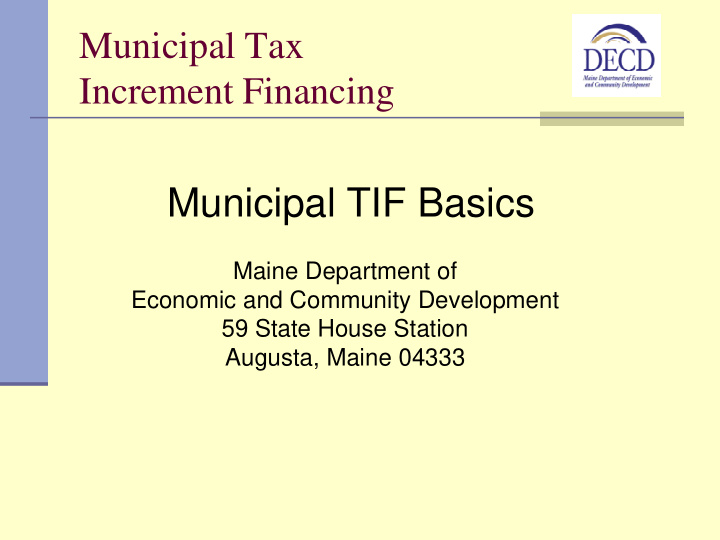



Municipal Tax Increment Financing Municipal TIF Basics Maine Department of Economic and Community Development 59 State House Station Augusta, Maine 04333
Municipal Tax Increment Financing Brian S Hodges, Director of Tax Incentive Programs Office of the Commissioner, DECD brian.hodges@maine.gov (207) 624-7415 www.mainebiz.org
What Municipal TIF Is A local economic development project financing program, using real & personal property taxes A “shelter” against adjustments to education costs and county taxes based on State Valuation A flexible economic development tool
How It Works The municipality designates a specific geographic area as a Municipal Development Tax Increment Financing District ■ Municipal legislative body designates district ■ Local public process This “freezes” the value of taxable property within the district (the original assessed value or “OAV”) Municipality adopts a development program describing authorized uses of revenue DECD commissioner reviews and approves based upon statutory compliance
Establishing OAV The Original Assessed Value is the assessed value of a development district as of March 31 st of the prior tax year TIF application received by 03/01/2010 - use valuation as of 03/31/2009 - tax year 04/01/2008 – 03/31/2009 TIF application received 04/01/2010 to 03/01/2011 - use valuation as of 03/31/2010 - tax year 04/01/2009 – 03/31/2010
How It Works . . . TIF then applies to new value in the district Some or all of the new value in the TIF is “sheltered” (excluded) from State Valuation and therefore does not negatively impact the education costs or county taxes for the municipality
TIF Example (mil rate 20) Vacant Land Original Assessed Value: $100,000 X .02 = - $2,000 in Taxes Vacant Land Building Building: $300,000 X .02 = - $6,000 in new (Increment) Taxes
TIF Revenues Tax revenues generated from new value are used to implement development program ■ Municipality designates the percentage of increased value being “captured” ■ Percentage can range from 1% – 100% Tax Year Total Tax $ TIF % General Town TIF $ CEA 50% ED activities Total Town Fund 50% $ 100 2000 3000 500 3000 2010 8,000 100 100 1,000 1,000 100 2000 4000 550 4000 2011 10,000 -0- 100 1,100 1,100 2012 10,000 -0- 100 1,200 1,200 100 2000 4000 600 4000
Designation Process Notice of public hearing in newspaper of general circulation ten days before the public hearing Public hearing held and duly recorded Majority vote of municipal legislative body necessary to designate a TIF district and Development Program Approved application forwarded to DECD Commissioner reviews for statutory compliance Maine Revenue Services notified of DECD approval
Application & Development Program Application Components Cover sheet and job goals page Municipal Approvals Evidence of public hearing notice Minutes of public hearing Record of district designation by municipal legislative body
Application & Development Program Development Program Statement of means and objectives District area and value certifications Map and description of district Overview of the development project Summary description of financial plan List of public facilities being constructed (if any) Uses of private property within district Plans for relocation of persons displaced by development activities Proposed traffic improvements Environmental controls being applied Proposed operation of the district after completing capital improvements Duration of district (not to exceed 30 years)
Application & Development Program Financial Plan Cost estimates for the program Indebtedness being incurred Sources of anticipated revenues Calculations of tax shifts Estimates of Captured Assessed Value (CAV) CAV and tax increment revenues being applied to the DP
Authorized TIF Revenue Uses Tier I - Costs within the district Tier II - Costs outside but directly related to or made necessary by the district Tier III - Costs within the municipality
Tier I - Authorized Project Costs WITHIN THE DISTRICT Capital costs, including: Construction, improvements and site work Demolition, repair and remodeling Acquisition of equipment Financing costs, including: Premiums paid for early redemption of obligations Interest paid to holders of evidences of indebtedness issued to pay for project costs
Tier I - Authorized Project Costs... WITHIN THE DISTRICT Professional Services, including: Licensing and architectural Planning, engineering and legal Other costs, including: Reasonable administrative expenses Relocation expenses Organizational costs to establish district, like impact studies, and public information
Tier II - Authorized Project Costs... OUTSIDE THE DISTRICT DIRECTLY RELATED TO OR MADE NECESSARY BY IT Infrastructure improvements, including: Sewage or water treatment plants Sewer, water and electrical lines Street amenities and fire station improvements Other improvements, including: Public safety Adverse impact mitigation
Tier III - Authorized Project Costs... WITHIN THE MUNICIPALITY Economic Development Programs Environmental Improvement Plans Permanent Revolving Funds Employment Training (<20%) Quality Child Care Arts district activities Transit activities
Funding Mechanisms… Municipal Bonds Municipality establishes a Development Sinking Fund for debt service requirements Credit Enhancement Agreement (CEA) TIF revenues placed in a Project Cost Account for direct payment to company for authorized project costs Municipal Economic Development TIF revenues placed in a Project Cost Account for direct payment by town for authorized project costs
Prohibited Project Costs... The TIF statute specifically prohibits the following project costs: Those associated with buildings used predominately for the general conduct of government Public recreational purposes
Prohibited Project Costs... DOWNTOWN WAIVER State and Municipal Government may lease private facilities in a downtown TIF district and authorized project costs may include the construction or improvement of the facilities or buildings to be occupied
TIF District Limitations Geography District has boundaries and limits: single: 2% of area all: 5% of area all: 5% of value
TIF District Limitations… At least 25% of the district area must be: ■ Blighted ■ In need or rehabilitation, redevelopment or conservation; or, ■ Suitable for commercial uses
Policy Notes... Municipalities benefit from having a clearly articulated TIF policy: Requires a TIF “education” Requires public deliberation Articulates the will and values of the community Serves as a benchmark for the evaluation of projects requesting public investment Can serve as a negotiating tool
Summary A local economic development project financing program A “shelter” against adjustments to education costs and county taxes based on total valuation A flexible economic development tool
Recommend
More recommend